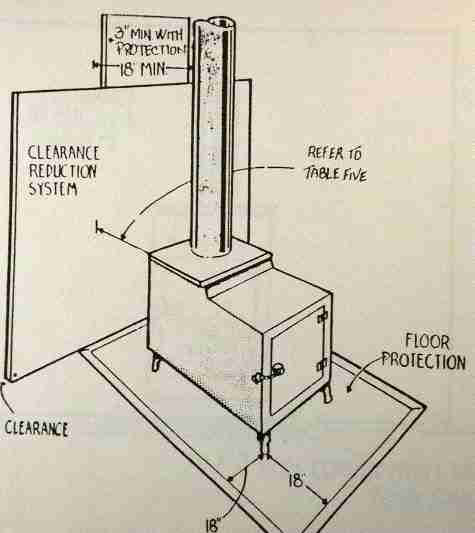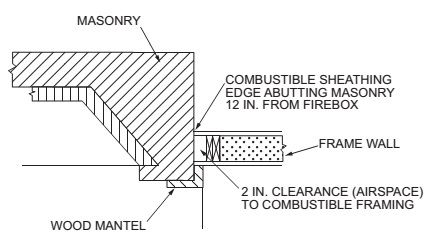Michigan Wood Stove Installation Codes
Bvent pipe of any type/# of walls, is intended for venting the 'hot' gases from combustion of propane or nautral gas. Its not intended for the MUCH HOTTER temps you will get from a wood stove! Regular single wall black or galvanized pipe can be used UNTIL the chimney encounters the first combustable surface, usually the interior ceiling in a roof vented system. From this point upward, (even after the stack exits the roof above the shingles) an all-fuel stainless steel pipe is required.

One such brand name is Metalbestos. I recommend heading to your local hardware/homecenter to get the lowdown on what you need. There you will get hands-on with the parts needed to do the job SAFELY. Trying to type out on a keyboard what you need is no way to handle this situation. Sorry to sound like a jerk, but doing this the wrong way can result in DEATH to you and your loved ones. I worked at a lumber yard/home center for 17 years. Its scary the number of people that came in and asked 'What do i need to do this?'
Wood Stove Installation Contractors
Id show them, then give the price and they'd say something like 'I'll just run black pipe all the way.its only my garage for cryin' out loud'. Our invoicing software allowed for salepeople to type 'description' lines on the bill of sale/invoice. In situations like these, I ALWAYS typed something like 'Customer was advised and shown the proper parts to do the job to code, and has made their own choice against my recommendations.' I'd inform them I was doing it too.
That got alot of them to reconsider their penny-pinching approach, or they'd say 'I think i'll just wait on it.' Makes me wonder how many of 'em were hoping for a 'mishap' and were planning on blaming the guy at the homecenter (ME!). I also agree with Ausable Junkie. Once installed, there's two things that I would also do. One, contact your insurance company and inform them that you'll be using 'solid fuel' (wood) in the garage. Second, depending on where you live and the 'code'. You should verify rather it will need inspection and approval.

I installed a wood furnace in our other garage (unattached to the home), did it to spec, but never had it inspected. I had to remove a couple pieces of ceiling, after I got my ask reamed out by the inspector for not calling him.

He wasn't that bad but, lets just say he wasn't happy about me not calling for the inspection before fireing it up. Everything was to code and it passed but, lesson learned on my wood furnace. I went through this exact thing a few years ago. 95% of insurance companies will not insure you if there is a woodstove in your gagage.
I finally found one that did when I initially bought my house. A couple of years later, I found a new insurance company to save a couple of bucks. Oxford dictionary english to hindi free download full version for pc torrent.
The new insurance company said that there would be no problem at all, so I went with them. They even took pictures of the stove, which was on concrete with a brick wall behind it. Things were fine until my mortgage company called 3 months later and asked me why I had no insurance - they didnt even tell me that they were in the process of canceling my policy. It was a headache, to put it mildly. The reaon they gave me was 'people usually pile stuff all around the woodstove if it is only occasionally used'. About Us Founded in 1999, Michigan-Sportsman.com started as a collection of links to Michigan related sites, and a series of manually edited blogs. It was a marriage of my passions for the outdoors and the internet.
In late 1999, we started our first message board. It was one of Michigan's first social networks. Many off-site friendships have formed with others who share the same interests in the outdoors through the site. Thanks for your patronage - Steve. Site Functions. Useful Links.
Support the site! The management works very hard to make sure the community is running the best software, best designs, and all the other bells and whistles. Care to buy us a beer? We'd really appreciate it!
InspectAPedia tolerates no conflicts of interest. Fire Clearances for Flues for Woodstoves & Coal stovesOur photo at the top of thi page shows an unsafe wood fireplace installation that lacks adequate clearance from combustibles.Notice also that the connection between the fireplace top and the flue is upside-down and that considerable leakage has occurred out of the flue onto the fireplace top.Some basic rule of thumb fire clearances for woodstoves are shown in the sketch at left. (Click to enlarge the image).Watch out:Check with your local fire marshall about local building code requirements for fire-clearance distances before installing and using a wood stove, coal stove, or other auxiliary heat source. Making a mistake can lead to a dangerous building fire. Child safety: 36' safety zone around Wood Stoves & Pellet StovesWatch out: Use whatever means necessary to create a 36-inch safety zone around any heating equipment that can get hot enough to burn a child.Keep small children out of this space. Specific Fire Safety Clearance Distances for Un-Certified Wood Stoves & Pellet StovesIn the U.S. Certification is monitored by the U.S.
EPA who provide a List of EPA Certified Wood Heaters given below. The Canadian Standards Association (CSA) and the U.S. Wood Heat Safety Organization also provide consistent recommendations for wood stoves that are not carry a certification label. Certifying agencies and standards for other countries are given below.Click to enlarge any imageFire safety clearance distances are measured from the closest point of the outer surface of the heating appliance to the closest point of nearby wall, floor or ceiling or to other combustible materials that might be nearby.The wall finish surface, such as drywall is not considered in evaluating the heat resistance or fire safety of the heating appliance.At left is a free-standing wood-burning fireplace installed by the author in the 1970's. Installation was incomplete - no adequate fire shielding was yet provided for this heater.I (DF) lived with this stove as a sole heat source in a different home in the early 1970's and can tell you it is not a design I recommend. I would not install this fireplace today.Watch out: the free-standing fireplace shown is not a safe installation.
While it had a damper controlling the flue to slow burn rate the front of the stove was open except for a screen - a big heat loser for the building as combustion can only be controlled by intelligence: don't build a big fire.And the installation as shown does not meet required clearances to combustibles. Un-certified woodstove clearance distances: 48' to combustibles at sides, rear, and corners as well as the 'fueling' or or ash removal side of the the heater. This distance might be reduced to 36' with an approved heat shield. Un-certified woodstove clearance distance: 60' above the stove top to the ceiling or any combustible above the heater. Un-certified woodstove clearance distances when the stove has a sheet metal jacket or casing = 36' to combustiblesGeneral Fire Safety Clearance Distances for Listed or Certified Wood Stoves & Pellet StovesAt left is the permanently affixed certification and data tag from a Jotul No. 118 wood stove that has been in service for more than 20 years in New York.